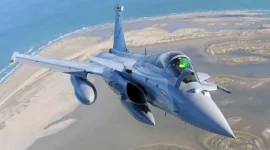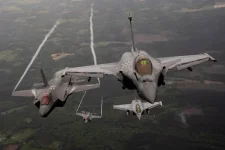- Views: 4K
- Replies: 10
India's initiative towards greater self-sufficiency in defence manufacturing is set to receive a major impetus as the Indian Air Force (IAF) and Navy prepare to equip their Rafale fighter jets with the indigenous BrahMos-NG (Next Generation) supersonic cruise missile.
This development follows a crucial agreement with French aviation major Dassault Aviation, which has consented to integrate Indian-developed weapon systems onto the advanced aircraft, marking a significant enhancement of the Rafale's operational capabilities within India's strategic framework.
The BrahMos-NG, a lighter and more compact iteration of the existing BrahMos missile, is slated for trials in 2026. Production is planned at a new facility currently under construction in Lucknow, Uttar Pradesh.
This advanced missile system is anticipated to become a vital component of India's aerial arsenal, not only for the Rafale but also for the Su-30MKI and the Tejas Mk1A fighter aircraft.
Developed by BrahMos Aerospace, a collaborative venture between India's Defence Research and Development Organisation (DRDO) and Russia’s NPO Mashinostroyeniya, the BrahMos-NG boasts impressive specifications.
Weighing between 1.3 and 1.4 tonnes, the missile measures 6 metres in length and has a diameter of 50 centimetres. This makes it approximately 50% lighter and 3 metres shorter than its predecessor, while still achieving a range of 290 kilometres and a top speed of Mach 3.5 (3.5 times the speed of sound).
The missile is engineered for launch from various platforms including aircraft, land-based launchers, ships, and submarines.
Its design incorporates a reduced radar cross-section (RCS) for improved stealth and an advanced seeker featuring Active Electronically Scanned Array (AESA) radar, enhancing its targeting precision.
The IAF has already signalled its intent to acquire 400 units of the BrahMos-NG, with an estimated cost of ₹8,000 crore, and deliveries are anticipated to commence within five years of production starting.
Dassault Aviation's commitment to integrating Indian weaponry on both the Navy’s Rafale-M and the Air Force’s Rafale C versions addresses a long-standing strategic requirement to reduce reliance on foreign munitions.
Currently, Rafale jets are equipped with French missiles such as the Exocet, which has a more limited range of around 70 kilometres. The BrahMos-NG, with its significantly longer range of 290 kilometres and supersonic speed, will allow Rafale pilots to engage enemy naval and land targets from much safer distances, placing them beyond the effective reach of many contemporary air defence systems.
This capability enhancement is particularly crucial for the Navy's 26 Rafale-M aircraft, destined for operations from the aircraft carriers INS Vikramaditya and INS Vikrant, and for the IAF’s 36 Rafale C jets, which operate from airbases in Ambala and Hasimara.
The integration process for the BrahMos-NG on the Rafale will commence following initial trials on the Su-30MKI aircraft, which are expected in late 2025 or early 2026. Pravin Pathak, Director of BrahMos Export, confirmed this timeline at the World Defense Show in February 2024.
The Su-30MKI, with its capacity to carry up to three BrahMos-NG missiles owing to its substantial payload capability, will serve as the initial test platform for the air-launched version of the missile.
Upon successful completion of these trials, the IAF intends to extend the integration to its Tejas Mk1A and Rafale fleets. The Tejas Mk1A, with 83 units scheduled for delivery starting in 2025, is expected to carry one BrahMos-NG missile.
The Rafale is anticipated to initially be configured to carry a single missile, with potential for future upgrades to a twin-missile load-out, similar to earlier considerations for the Rafale with the Scalp missile.
Manufacturing of the BrahMos-NG will be undertaken at a new 200-acre facility in Lucknow. This plant, currently under construction, is projected to become operational in 2026 and is expected to produce between 80 and 100 missiles annually.
This production capacity will cater to India's domestic requirements and also support export orders, such as the recent BrahMos system deliveries to the Philippines.
However, the integration timeline for the Rafale may encounter complexities. The prior integration of the BrahMos-A missile with the Su-30MKI, which concluded in 2017, was a detailed undertaking involving mechanical, electrical, and software modifications by Hindustan Aeronautics Limited (HAL) and BrahMos Aerospace. This process faced delays due to issues related to technology transfer.
Similar challenges could arise with the Rafale integration, given the differences in communication protocols between the French-made aircraft and the Indo-Russian missile.
Defence analysts have suggested that developing intermediary hardware to bridge data communication, coupled with robust agreements to safeguard intellectual property, could offer a viable path forward, though this will necessitate meticulous coordination between all parties involved.


